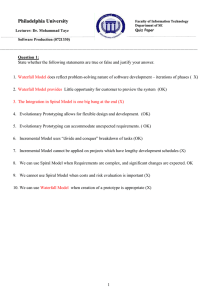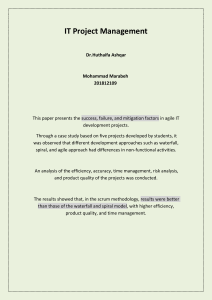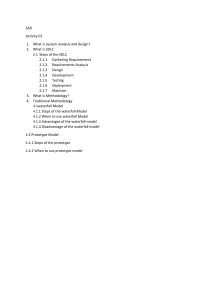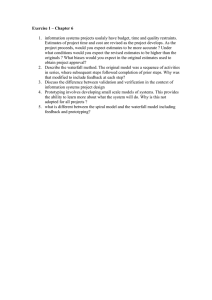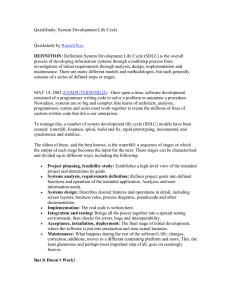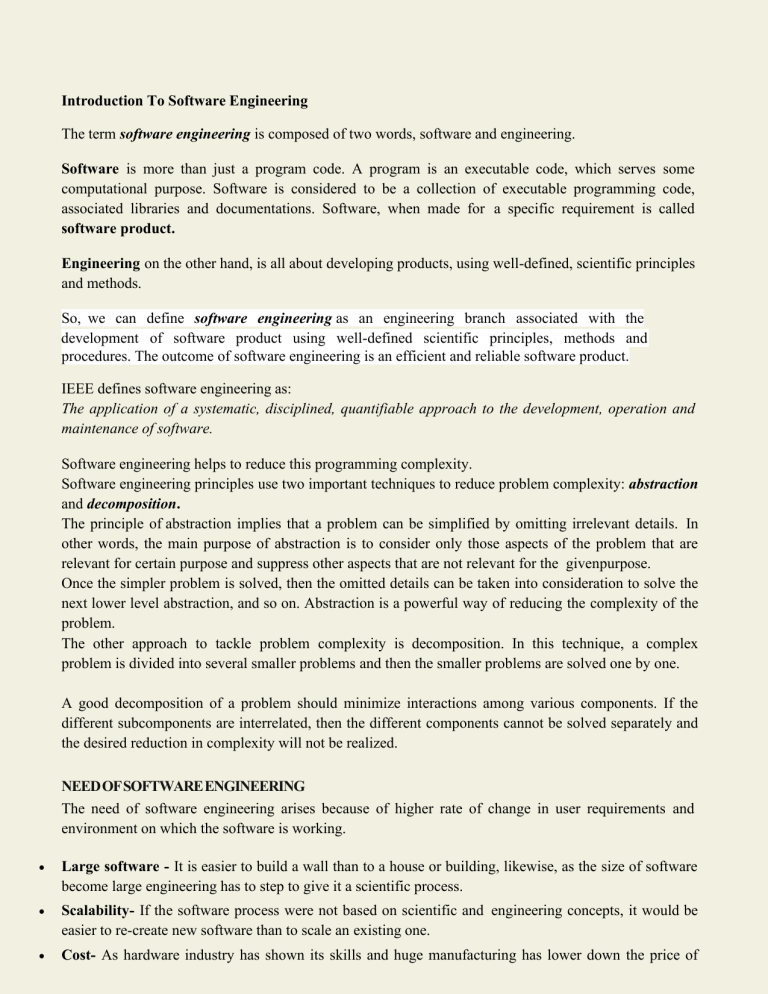
Introduction To Software Engineering The term software engineering is composed of two words, software and engineering. Software is more than just a program code. A program is an executable code, which serves some computational purpose. Software is considered to be a collection of executable programming code, associated libraries and documentations. Software, when made for a specific requirement is called software product. Engineering on the other hand, is all about developing products, using well-defined, scientific principles and methods. So, we can define software engineering as an engineering branch associated with the development of software product using well-defined scientific principles, methods and procedures. The outcome of software engineering is an efficient and reliable software product. IEEE defines software engineering as: The application of a systematic, disciplined, quantifiable approach to the development, operation and maintenance of software. Software engineering helps to reduce this programming complexity. Software engineering principles use two important techniques to reduce problem complexity: abstraction and decomposition. The principle of abstraction implies that a problem can be simplified by omitting irrelevant details. In other words, the main purpose of abstraction is to consider only those aspects of the problem that are relevant for certain purpose and suppress other aspects that are not relevant for the givenpurpose. Once the simpler problem is solved, then the omitted details can be taken into consideration to solve the next lower level abstraction, and so on. Abstraction is a powerful way of reducing the complexity of the problem. The other approach to tackle problem complexity is decomposition. In this technique, a complex problem is divided into several smaller problems and then the smaller problems are solved one by one. A good decomposition of a problem should minimize interactions among various components. If the different subcomponents are interrelated, then the different components cannot be solved separately and the desired reduction in complexity will not be realized. NEED OF SOFTWARE ENGINEERING The need of software engineering arises because of higher rate of change in user requirements and environment on which the software is working. • Large software - It is easier to build a wall than to a house or building, likewise, as the size of software become large engineering has to step to give it a scientific process. • Scalability- If the software process were not based on scientific and engineering concepts, it would be easier to re-create new software than to scale an existing one. • Cost- As hardware industry has shown its skills and huge manufacturing has lower down the price of computer and electronic hardware. But the cost of software remains high if proper process is not adapted. • Dynamic Nature- The always growing and adapting nature of software hugely depends upon the environment in which the user works. If the nature of software is always changing, new enhancements need to be done in the existing one. This is where software engineering plays a good role. • Quality Management- Better process of software development provides better and quality software product. CHARACTERESTICS OF GOOD SOFTWARE A software product can be judged by what it offers and how well it can be used. This software must satisfy on the following grounds: • Operational • Transitional • Maintenance Well-engineered and crafted software is expected to have the following characteristics: Operational This tells us how well software works in operations. It can be measured on: • Budget • Usability • Efficiency • Correctness • Functionality • Dependability • Security • Safety Transitional This aspect is important when the software is moved from one platform to another: • Portability • Interoperability • Reusability • Adaptability • Maintenance This aspect briefs about how well a software has the capabilities to maintain itself in the everchanging environment: Modularity • Maintainability • Flexibility • Scalability In short, Software engineering is a branch of computer science, which uses well-defined engineering concepts required to produce efficient, durable, scalable, in-budget and on-time software products Software Process A software process (also knows as software methodology) is a set of related activities that leads to the production of the software. These activities may involve the development of the software from the scratch, or, modifying an existing system. Any software process must include the following four activities: 1. Software specification (or requirements engineering): Define the main functionalities of the software and the constrains around them. 2. Software design and implementation: The software is to be designed and programmed. 3. Software verification and validation: The software must conforms to it’s specification and meets the customer needs. 4. Software evolution (software maintenance): The software is being modified to meet customer and market requirements changes. In practice, they include sub-activities such as requirements validation, architectural design, unit testing, …etc. There are also supporting activities such as configuration and change management, quality assurance, project management, user experience. What is Software Quality? Software Quality shows how good and reliable a product is. To convey an associate degree example, think about functionally correct software. It performs all functions as laid out in the SRS document. But, it has an associate degree virtually unusable program. even though it should be functionally correct, we tend not to think about it to be a high-quality product. Another example is also that of a product that will have everything that the users need but has an associate degree virtually incomprehensible and not maintainable code. Therefore, the normal construct of quality as “fitness of purpose” for code merchandise isn’t satisfactory. Factors of Software Quality The modern read of high-quality associates with software many quality factors like the following: 1. Portability: A software is claimed to be transportable, if it may be simply created to figure in several package environments, in several machines, with alternative code merchandise, etc. 2. Usability: A software has smart usability if completely different classes of users (i.e. knowledgeable and novice users) will simply invoke the functions of the merchandise. 3. Reusability: A software has smart reusability if completely different modules of the merchandise will simply be reused to develop new merchandise. 4. Correctness: Software is correct if completely different needs as laid out in the SRS document are properly enforced. 5. Maintainability: A software is reparable, if errors may be simply corrected as and once they show up, new functions may be simply added to the merchandise, and therefore the functionalities of the merchandise may be simply changed, etc 6. Reliability. Software is more reliable if it has fewer failures. Since software engineers do not deliberately plan for their software to fail, reliability depends on the number and type of mistakes they make. Designers can improve reliability by ensuring the software is easy to implement and change, by testing it thoroughly, and also by ensuring that if failures occur, the system can handle them or can recover easily. 7. Efficiency. The more efficient software is, the less it uses of CPU-time, memory, disk space, network bandwidth, and other resources. This is important to customers in order to reduce their costs of running the software, although with today’s powerful computers, CPU time, memory and disk usage are less of a concern than in years gone by. SOFTWARE DEVELOPMENT LIFE CYCLE LIFE CYCLE MODEL A software life cycle model (also called process model) is a descriptive and diagrammatic representation of the software life cycle. A life cycle model represents all the activities required to make a software product transit through its life cycle phases. It also captures the order in which these activities are to be undertaken. In other words, a life cycle model maps the different activities performed on a software product from its inception to retirement. Different life cycle models may map the basic development activities to phases in different ways. Thus, no matter which life cycle model is followed, the basic activities are included in all life cycle models though the activities may be carried out in different orders in different life cycle models. During any life cycle phase, more than one activity may also be carried out. THE NEED FOR A SOFTWARE LIFE CYCLE MODEL The development team must identify a suitable life cycle model for the particular project and then adhere to it. Without using of a particular life cycle model the development of a software product would not be in a systematic and disciplined manner. When a software product is being developed by a team there must be a clear understanding among team members about when and what to do. Otherwise it would lead to chaos and project failure. Suppose a software development problem is divided into several parts and the parts are assigned to the team members. From then on, suppose the team members are allowed the freedom to develop the parts assigned to them in whatever way they like. It is possible that one member might start writing the code for his part, another might decide to prepare the test documents first, and some other engineer might begin with the design phase of the parts assigned to him. This would be one of the perfect recipes for project failure. A software life cycle model defines entry and exit criteria for every phase. A phase can start only if its phase-entry criteria have been satisfied. So without software life cycle model the entry and exit criteria for a phase cannot be recognized. Without software life cycle models it becomes difficult for software project managers to monitor the progress of the project. Different software life cycle models Many life cycle models have been proposed so far. Each of them has some advantages as well as some disadvantages. A few important and commonly used life cycle models are as follows: • Classical Waterfall Model • • • • Iterative Waterfall Model Prototyping Model Evolutionary Model Spiral Model 1. CLASSICAL WATERFALL MODEL The classical waterfall model is intuitively the most obvious way to develop software. Though the classical waterfall model is elegant and intuitively obvious, it is not a practical model in the sense that it cannot be used in actual software development projects. Thus, this model can be considered to be a theoretical way of developing software. But all other life cycle models are essentially derived from the classical waterfall model. So, in order to be able to appreciate other life cycle models it is necessary to learn the classical waterfall model. Classical waterfall model divides the life cycle into the following phases as shown in fig.2.1: Fig 2.1: Classical Waterfall Model Feasibility study - The main aim of feasibility study is to determine whether it would be financially and technically feasible to develop the product. • At first project managers or team leaders try to have a rough understanding of what is required to be done by visiting the client side. They study different input data to the system and output data to be produced by the system. They study what kind of processing is needed to be done on these data and they look at the various constraints on the behavior of the system. • After they have an overall understanding of the problem they investigate the different solutions that are possible. Then they examine each of the solutions in terms of what kind of resources required, what would be the cost of development and what would be the development time for each solution. • Based on this analysis they pick the best solution and determine whether the solution is feasible financially and technically. They check whether the customer budget would meet the cost of the product and whether they have sufficient technical expertise in the area of development. Requirements analysis and specification: - The aim of the requirements analysis and specification phase is to understand the exact requirements of the customer and to document them properly. This phase consists of two distinct activities, namely • • Requirements gathering and analysis Requirements specification The goal of the requirements gathering activity is to collect all relevant information from the customer regarding the product to be developed. This is done to clearly understand the customer requirements so that incompleteness and inconsistencies are removed. For example, to perform the requirements analysis of a business accounting software required by an organization, the analyst might interview all the accountants of the organization to ascertain their requirements. The data collected from such a group of users usually contain several contradictions and ambiguities, since each user typically has only a partial and incomplete view of the system. Therefore it is necessary to identify all ambiguities and contradictions in the requirements and resolve them through further discussions with the customer. After all ambiguities, inconsistencies, and incompleteness have been resolved and all the requirements properly understood, the requirements specification activity can start. During this activity, the user requirements are systematically organized into a Software Requirements Specification (SRS) document. The customer requirements identified during the requirements gathering and analysis activity are organized into a SRS document. The important components of this document are functional requirements, the nonfunctional requirements, and the goals of implementation. Design: - The goal of the design phase is to transform the requirements specified in the SRS document into a structure that is suitable for implementation in some programming language. In technical terms, during the design phase the software architecture is derived from the SRS document. Two distinctly different approaches are available: the traditional design approach and the object-oriented design approach. • • Traditional design approach -Traditional design consists of two different activities; first a structured analysis of the requirements specification is carried out where the detailed structure of the problem is examined. This is followed by a structured design activity. During structured design, the results of structured analysis are transformed into thesoftware design. Object-oriented design approach -In this technique, various objects that occur in the problem domain and the solution domain are first identified, and the different relationships that exist among these objects are identified. The object structure is further refined to obtain the detailed design. Coding and unit testing:-The purpose of the coding phase (sometimes called the implementation phase) of software development is to translate the software design into source code. Each component of the design is implemented as a program module. The end-product of this phase is a set of program modules that have been individually tested. During this phase, each module is unit tested to determine the correct working of all the individual modules. It involves testing each module in isolation as this is the most efficient way to debug the errors identified at this stage. Integration and system testing: -Integration of different modules is undertaken once they have been coded and unit tested. During the integration and system testing phase, the modules are integrated in a planned manner. The different modules making up a software product are almost never integrated in one shot. Integration is normally carried out incrementally over a number of steps. During each integration step, the partially integrated system is tested and a set of previously planned modules are added to it. Finally, when all the modules have been successfully integrated and tested, system testing is carried out. The goal of system testing is to ensure that the developed system conforms to its requirements laid out in the SRS document. System testing usually consists of three different kinds of testing activities: • • • α – testing: It is the system testing performed by the development team. β –testing: It is the system testing performed by a friendly set of customers. Acceptance testing: It is the system testing performed by the customer himself after theproduct delivery to determine whether to accept or reject the delivered product. System testing is normally carried out in a planned manner according to the system test plan document. The system test plan identifies all testing-related activities that must be performed, specifies the schedule of testing, and allocates resources. It also lists all the test cases and the expected outputs for each test case. • • • Maintenance: -Maintenance of a typical software product requires much more than the effort necessary to develop the product itself. Many studies carried out in the past confirm this and indicate that the relative effort of development of a typical software product to its maintenance effort is roughly in the 40:60 ratios. Maintenance involves performing any one or more of the following three kinds of activities: Correcting errors that were not discovered during the product development phase. This is called corrective maintenance. Improving the implementation of the system, and enhancing the functionalities of the system according to the customer’s requirements. This is called perfective maintenance. Porting the software to work in a new environment. For example, porting may be required to get the software to work on a new computer platform or with a new operating system. This is called adaptive maintenance. Shortcomings of the classical waterfall model • • • • • The classical waterfall model is an idealistic one since it assumes that no development error is ever committed by the engineers during any of the life cycle phases. However, in practical development environments, the engineers do commit a large number of errors in almost every phase of the life cycle. The source of the defects can be many: oversight, wrong assumptions, use of inappropriate technology, communication gap among the project engineers, etc. These defects usually get detected much later in the life cycle. For example, a design defect might go unnoticed till we reach the coding or testing phase. Once a defect is detected, the engineers need to go back to the phase where the defect had occurred and redo some of the work done during that phase and the subsequent phases to correct the defect and its effect on the later phases. Therefore, inany practical software development work, it is not possible to strictly follow the classicalwaterfall model. ITERATIVE WATERFALL MODEL To overcome the major shortcomings of the classical waterfall model, we come up with the iterative waterfall model. Fig 3.1 : Iterative Waterfall Model Here, we provide feedback paths for error correction as & when detected later in a phase. Though errors are inevitable, but it is desirable to detect them in the same phase in which they occur. If so, this can reduce the effort to correct the bug. The advantage of this model is that there is a working model of the system at a very early stage of development which makes it easier to find functional or design flaws. Finding issues at an early stage of development enables to take corrective measures in a limited budget. The disadvantage with this SDLC model is that it is applicable only to large and bulky software development projects. This is because it is hard to break a small software system into further small serviceable increments/modules. PRTOTYPING MODELPrototype A prototype is a toy implementation of the system. A prototype usually exhibits limited functional capabilities, low reliability, and inefficient performance compared to the actual software. A prototype is usually built using several shortcuts. The shortcuts might involve using inefficient, inaccurate, or dummy functions. The shortcut implementation of a function, for example, may produce the desired results by using a table look-up instead of performing the actual computations. A prototype usually turns out to be a very crude version of theactual system. Need for a prototype in software development There are several uses of a prototype. An important purpose is to illustrate the input data formats, messages, reports, and the interactive dialogues to the customer. This is a valuable mechanism for gaining better understanding of the customer’s needs: • • • how the screens might look like how the user interface would behave how the system would produce outputs Another reason for developing a prototype is that it is impossible to get the perfect product in the first attempt. Many researchers and engineers advocate that if you want to develop a good product you must plan to throw away the first version. The experience gained in developing the prototype can be used to develop the final product. A prototyping model can be used when technical solutions are unclear to the development team. A developed prototype can help engineers to critically examine the technical issues associated with the product development. Often, major design decisions depend on issues like the response time of a hardware controller, or the efficiency of a sorting algorithm, etc. In such circumstances, a prototype may be the best or the only way to resolve the technical issues. A prototype of the actual product is preferred in situations such as: • User requirements are not complete • Technical issues are not clear Fig 3.2: Prototype Model EVOLUTIONARY MODEL It is also called successive versions model or incremental model. At first, a simple working model is built. Subsequently it undergoes functional improvements & we keep on adding new functions till the desired system is built. • • • • Applications: Large projects where you can easily find modules for incremental implementation. Often used when the customer wants to start using the core features rather than waiting for the full software. Also used in object oriented software development because the system can be easily portioned into units in terms of objects. Advantages: User gets a chance to experiment partially developed system • Reduce the error because the core modules get tested thoroughly. Disadvantages: It is difficult to divide the problem into several versions that would be acceptable to thecustomer which can be incrementally implemented & delivered. Fig 3.3: Evolutionary Model SPIRAL MODEL The Spiral model of software development is shown in fig. 4.1. The diagrammatic representation of this model appears like a spiral with many loops. The exact number of loops in the spiral is not fixed. Each loop of the spiral represents a phase of the software process. For example, the innermost loop might be concerned with feasibility study, the next loop with requirements specification, the next one with design, and so on. Each phase in this model is split into four sectors (or quadrants) as shown in fig. 4.1. The following activities are carried out during each phase of a spiral model. Fig 4.1: Spiral Model First quadrant (Objective Setting) • During the first quadrant, it is needed to identify the objectives of the phase. • Examine the risks associated with these objectives. Second Quadrant (Risk Assessment and Reduction) • A detailed analysis is carried out for each identified project risk. • Steps are taken to reduce the risks. For example, if there is a risk that therequirements are inappropriate, a prototype system may be developed. Third Quadrant (Development and Validation) • Develop and validate the next level of the product after resolving the identifiedrisks. Fourth Quadrant (Review and Planning) • Review the results achieved so far with the customer and plan the next iterationaround the spiral. • Progressively more complete version of the software gets built with each iterationaround the spiral. Circumstances to use spiral model The spiral model is called a meta model since it encompasses all other life cycle models. Risk handling is inherently built into this model. The spiral model is suitable for development of technically challenging software products that are prone to several kinds of risks. However, this model is much more complex than the other models – this is probably a factor deterring its use inordinary projects. Comparison of different life-cycle models The classical waterfall model can be considered as the basic model and all other life cycle models as embellishments of this model. However, the classical waterfall model cannot be used in practical development projects, since this model supports no mechanism to handle the errors committed during any of the phases. This problem is overcome in the iterative waterfall model. The iterative waterfall model is probably the most widely used software development model evolved so far. This model is simple to understand and use. However this model is suitable only for well-understood problems; it is not suitable for very large projects and for projects that are subject to many risks. The prototyping model is suitable for projects for which either the user requirements or the underlying technical aspects are not well understood. This model is especially popular for development of the userinterface part of the projects. The evolutionary approach is suitable for large problems which can be decomposed into a set of modules for incremental development and delivery. This model is also widely used for object- oriented development projects. Of course, this model can only be used if the incremental delivery of the system is acceptable to the customer. The spiral model is called a meta model since it encompasses all other life cycle models. Risk handling is inherently built into this model. The spiral model is suitable for development of technically challenging software products that are prone to several kinds of risks. However, this model is much more complex than the other models – this is probably a factor deterring its use inordinary projects. The different software life cycle models can be compared from the viewpoint of the customer. Initially, customer confidence in the development team is usually high irrespective of the development model followed. During the lengthy development process, customer confidence normally drops off, as no working product is immediately visible. Developers answer customer queries using technical slang, and delays are announced. This gives rise to customer resentment. On the other hand, an evolutionary approach lets the customer experiment with a working product much earlier than the monolithic approaches. Another important advantage of the incremental model is that it reduces the customer’s trauma of getting used to an entirely new system. The gradual introduction of the product via incremental phases provides time to the customer to adjust to the new product. Also, from the customer’s financial viewpoint, incremental development does not require a large upfront capital outlay. The customer can order the incremental versions as and when he can afford them.
